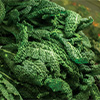
Featured Produce | Fall Quarterly 2020
Featured Produce: Apples
People have been relishing apples since at least 6,500 BC; charred remains of the fruit have been unearthed in prehistoric dwellings in Switzerland. While the only apple native to North America is the crabapple, settlers brought apple seeds to New York in the 1600s. The devoted nurseryman John Chapman (inspiration for the legendary Johnny Appleseed) established apple orchards across five states in the early 1800s. Now apples are grown widely in the United States, where the top apple-producing states are Washington, New York, Michigan, Pennsylvania, and California.
There's good reason to believe that an apple a day will help you avoid doctor's visits. Apples contain no fat, cholesterol, or sodium. According to the USDA, they are a rich source of pectin, an antioxidant, and they contain vitamin A, vitamin C, and dietary fiber. They also provide potassium, flavonoids, phytochemicals, and quercetin. To maximize all that good nutrition, save yourself some time and leave the peel on; two-thirds of the fiber and many antioxidants are found in the peel.
Over 17,000 varieties of apples have been tallied. You will find them with red, green, and yellow skins. Some are just a bit larger than a cherry while others are as big as a grapefruit. They range from pucker tart to satisfyingly sweet and from tender/soft to refreshingly crisp. Some apples are ideal for popping in a lunchbox, while others shine in cooking.
Different varieties are suitable for different growing climates, too. The top apple varieties grown in the United States by volume are: Red Delicious, Golden Delicious, Gala, Fuji, Granny Smith, McIntosh, Rome, Idared, Jonathan, Empire, York, Cortland, Northern Spy, Rhode Island Greening, and Honeycrisp.
Just a few of the many heirloom varieties include the Fall Pippin, Grimes Golden, American Beauty, Belmont, Golden Russet, Hawkeye Delicious, Ohio Beauty, Northwest Greening, and Winesap.
Fruity partners for apples include pears, lemons, limes, cranberries, rhubarb, raspberries, strawberries, grapes, figs, and dates. For nuts, look especially to almonds, walnuts, and pecans. Cheeses that play deliciously off the texture and taste of apples include Cheddar, goat, Brie, Swiss, Gouda, blue cheese, feta, and cream cheese. Sliced apples paired with a cardamom cream cheese dip is downright addictive! For seasonings, experiment with allspice, cardamom, cinnamon, cloves, fennel, ginger, mint, parsley, rosemary, and thyme.
Peak harvest season for apples is from September to late October, but throughout harvest season—late summer through November—you are likely to find a lively variety of apples at the Farmers’ Market or North Coast Co-op.
Develop your inner apple connoisseur by trying different varieties as they become available. For perfect specimens, choose those that are firm to the touch, with good aroma and no bruises or breaks in the skin.
The best storage conditions for apples are from 35 to 40 degrees, with relative humidity of 80 to 90 percent (they will ripen six to ten times faster at room temperature than in the refrigerator). Handle them gently, to avoid bruising, and store them away from strong-smelling foods, to keep them from absorbing odors.
As far as fruits go, apples are terrific keepers. Some varieties of apples can be stored even longer than others. These “storage apples" include Honeycrisp, Fuji, and Pink Lady.
Stock up on apples for snacking out-of-hand and enhancing many a dish, like this Parsnip Apple Soup.




